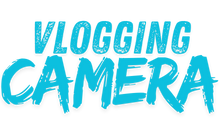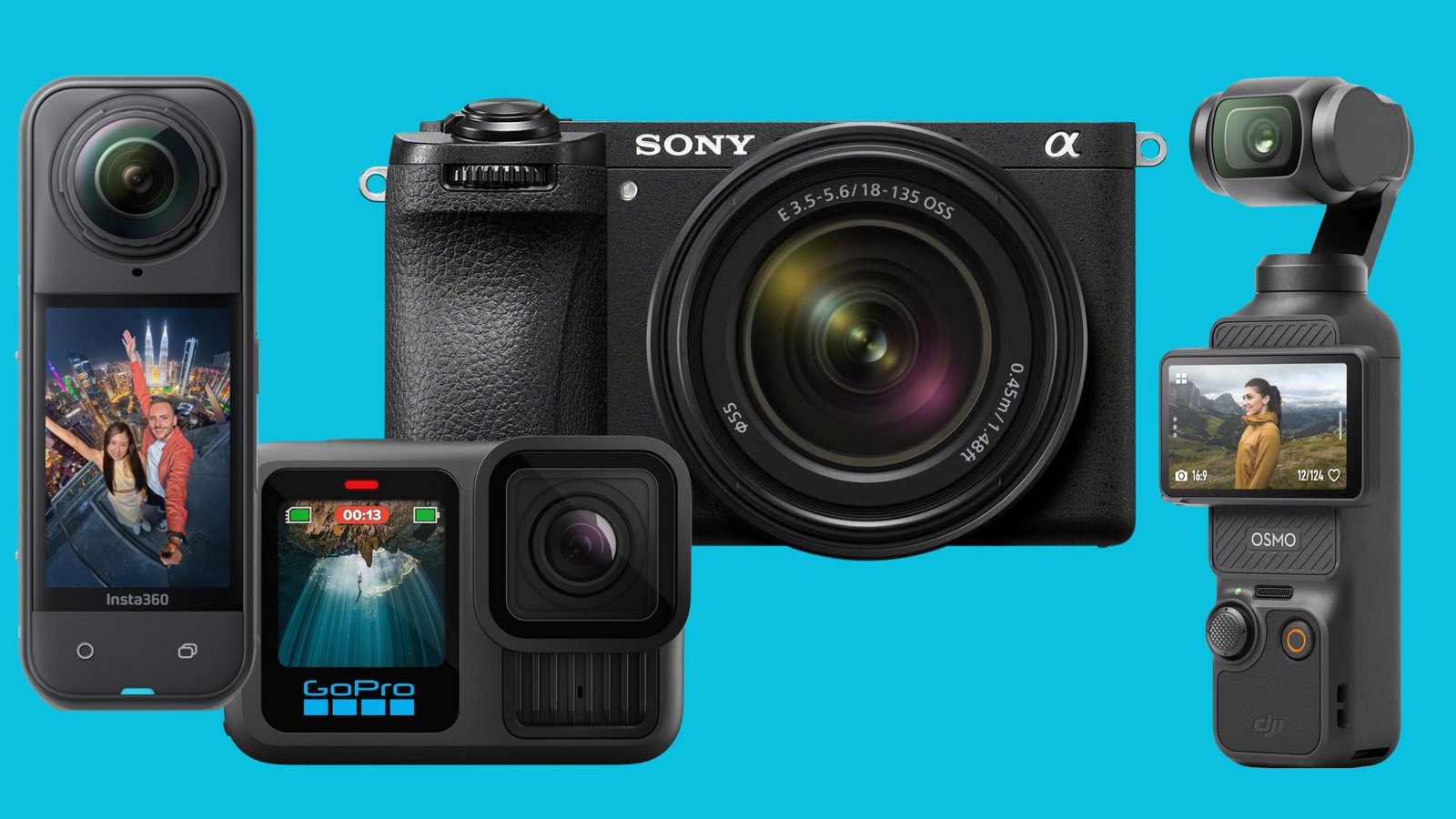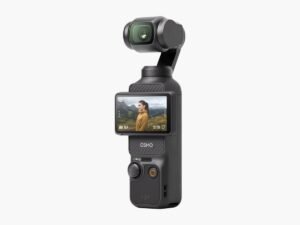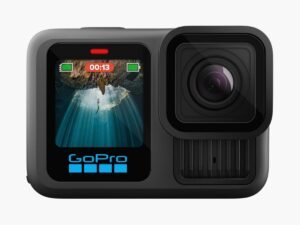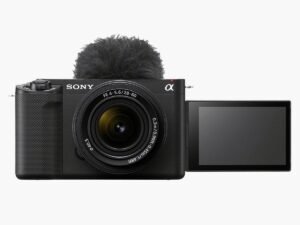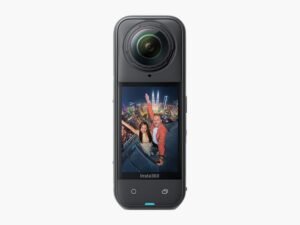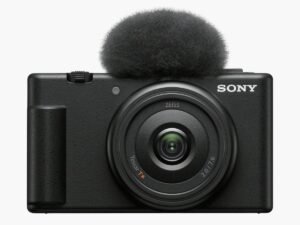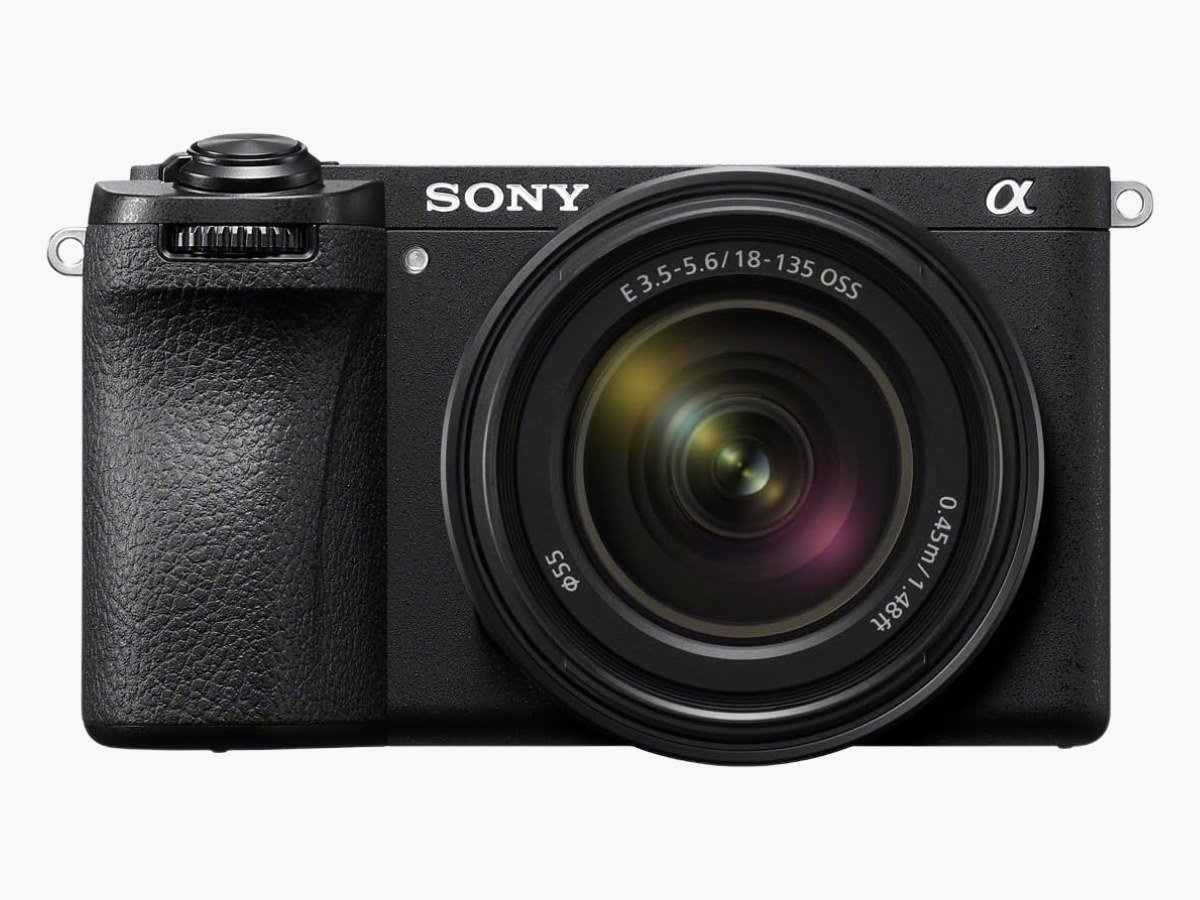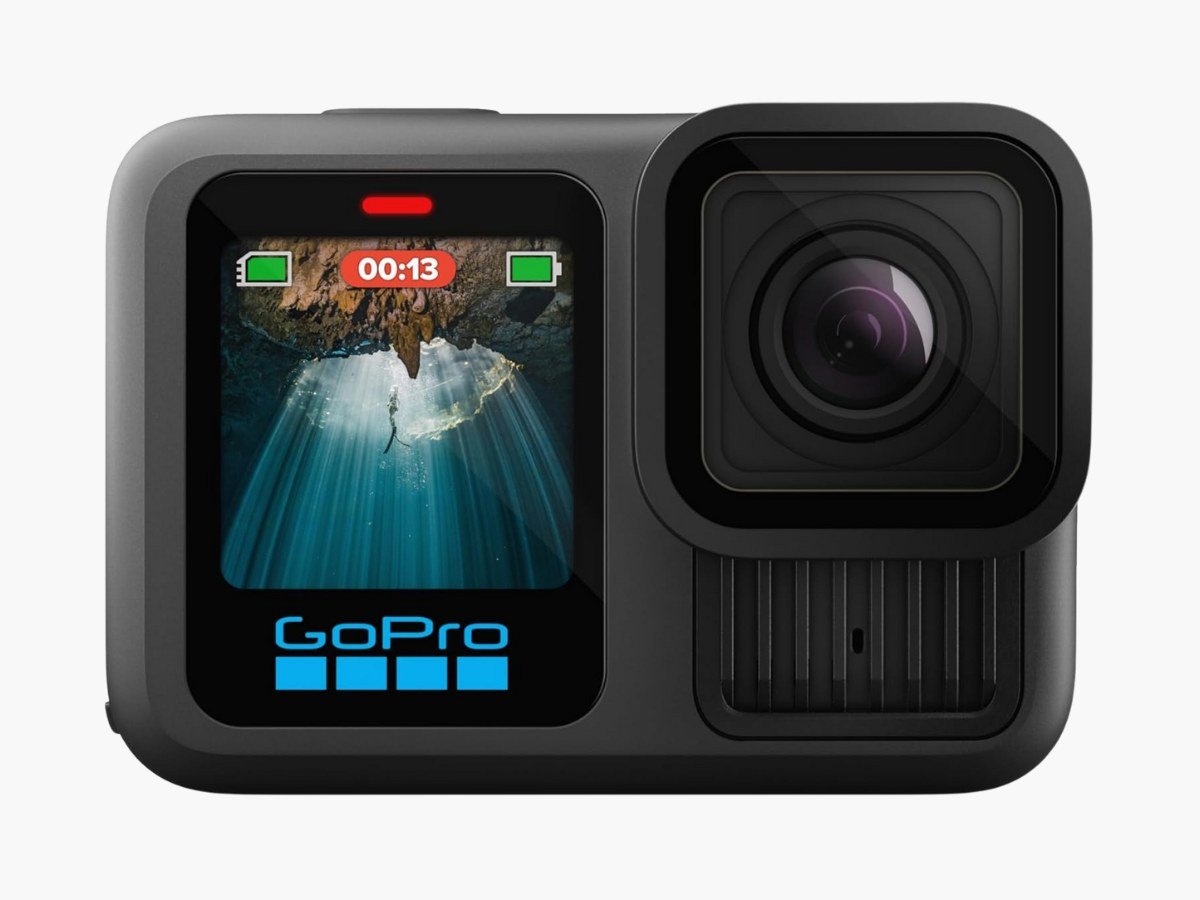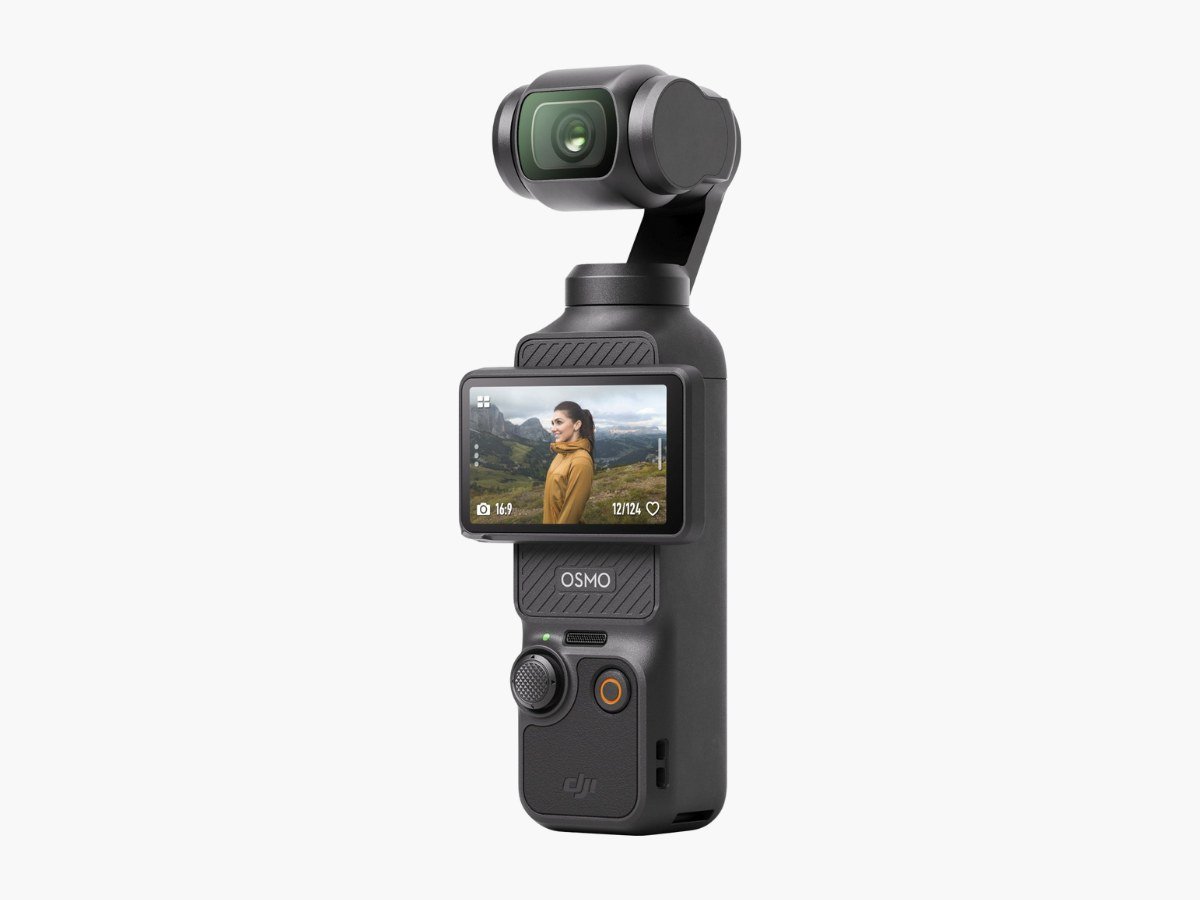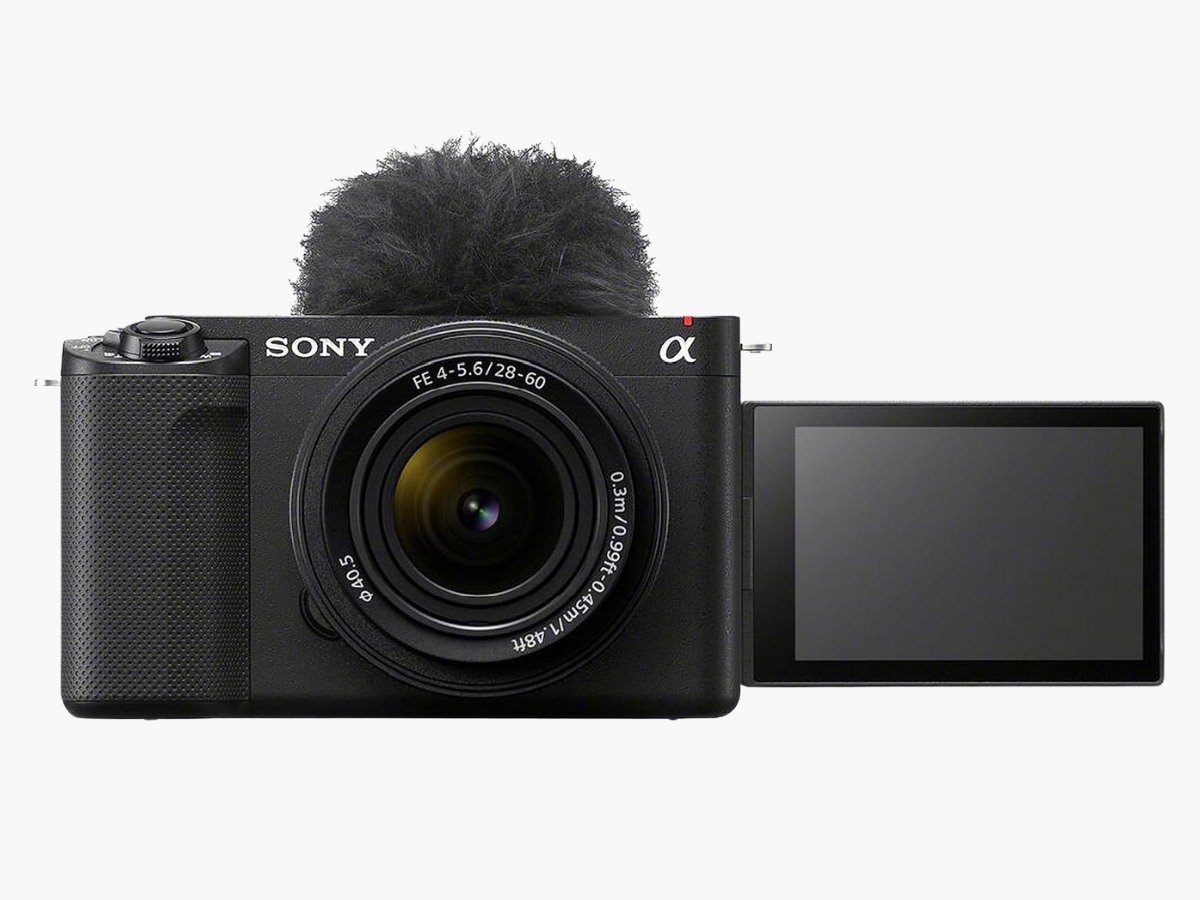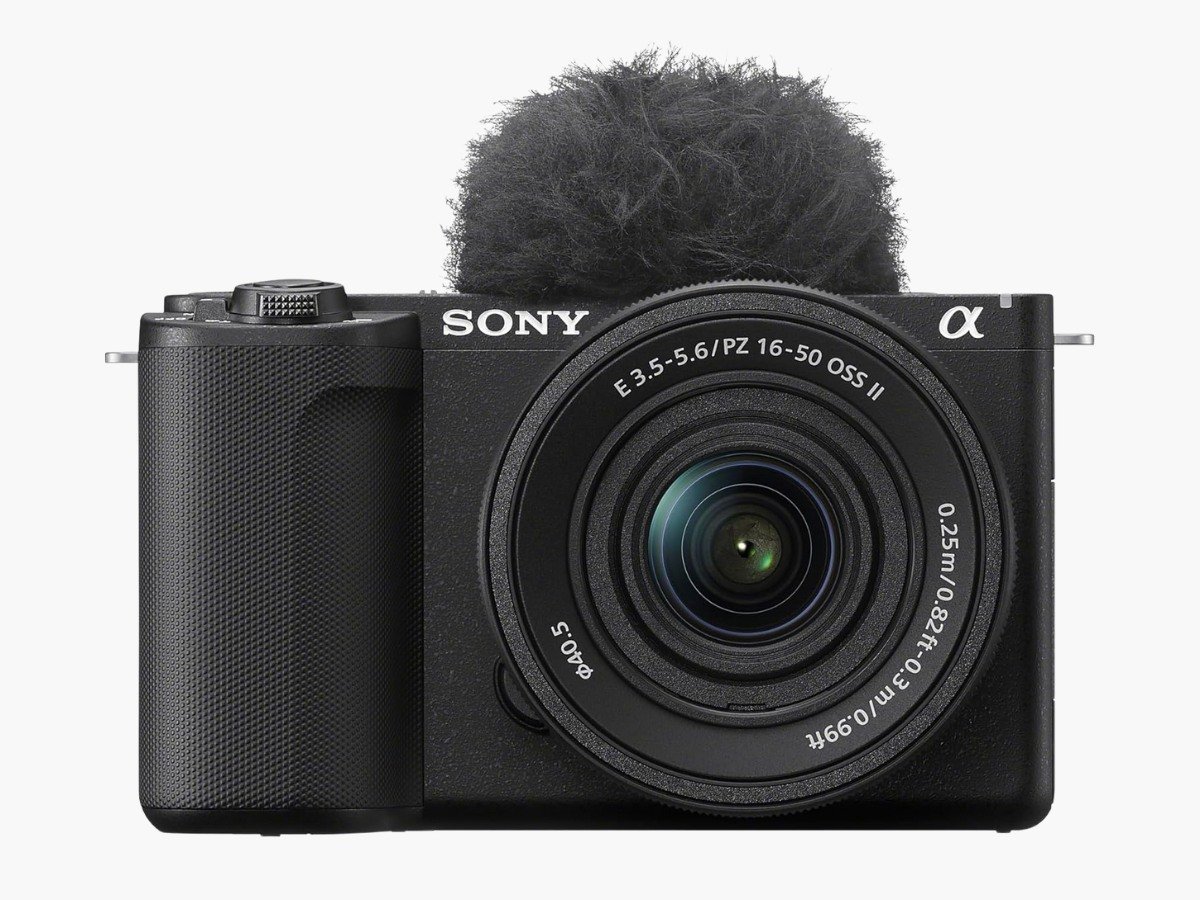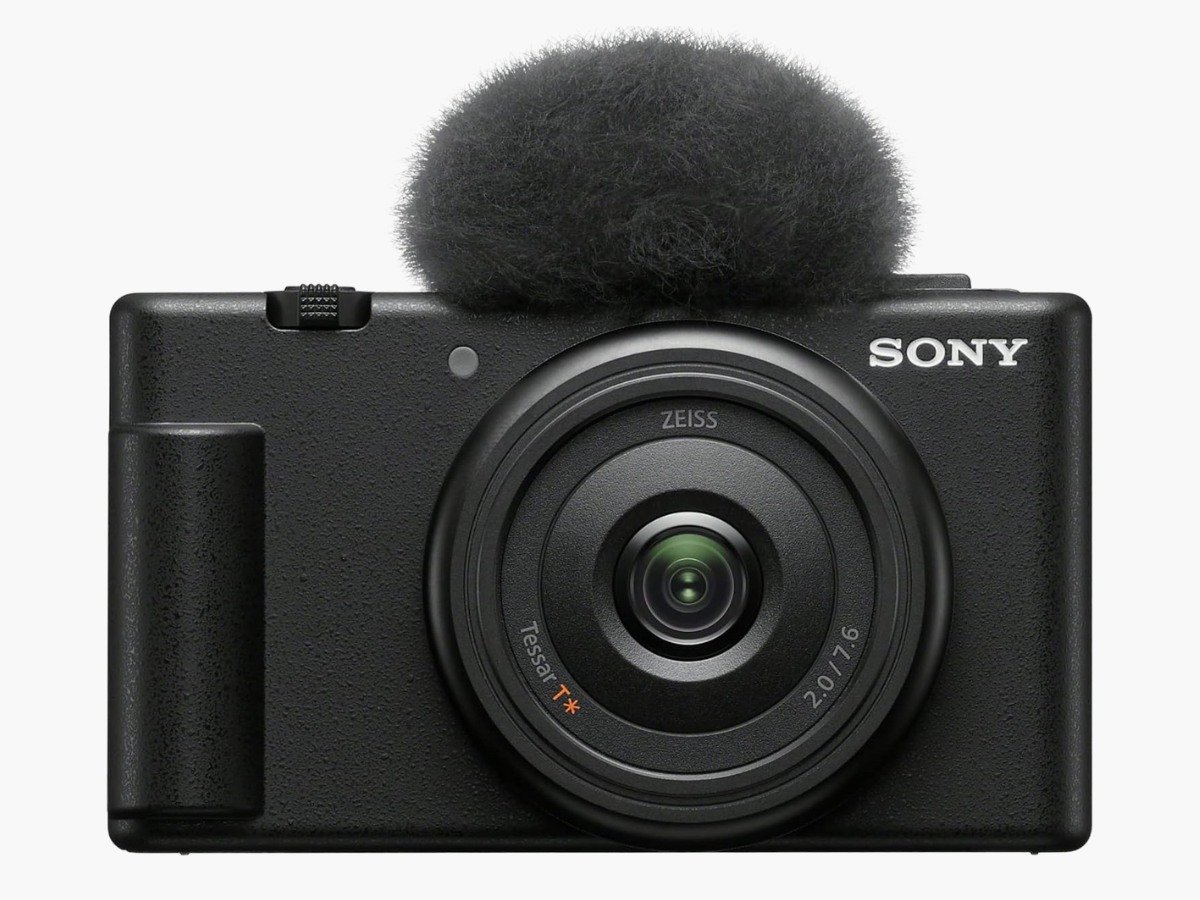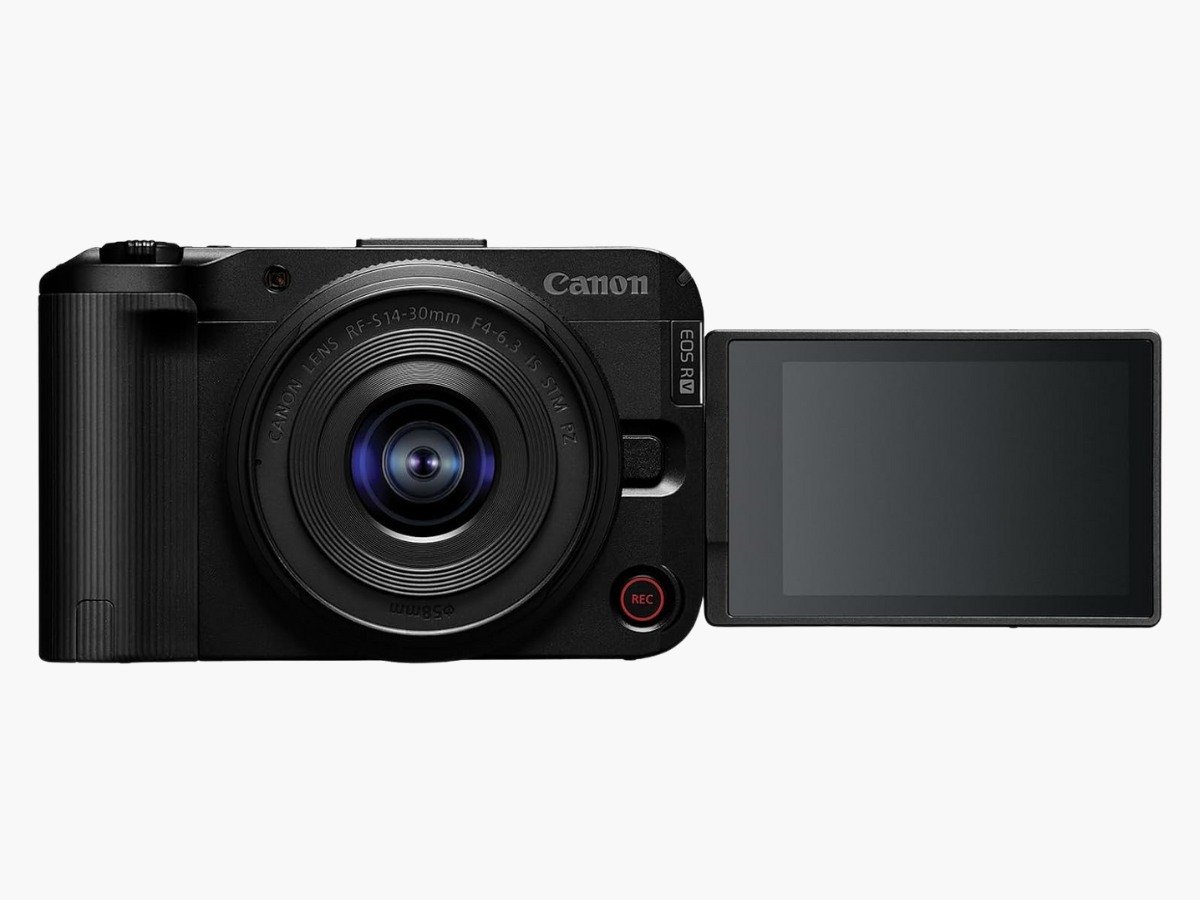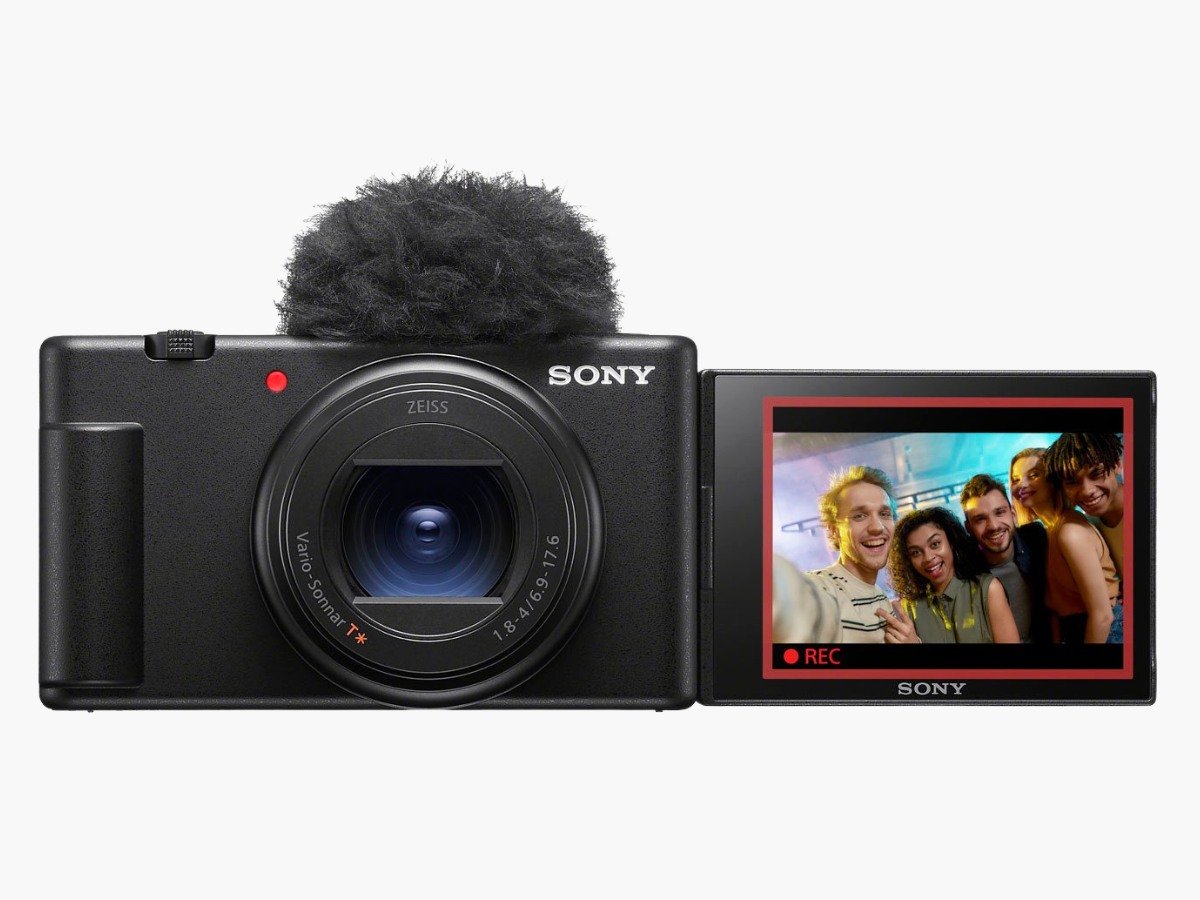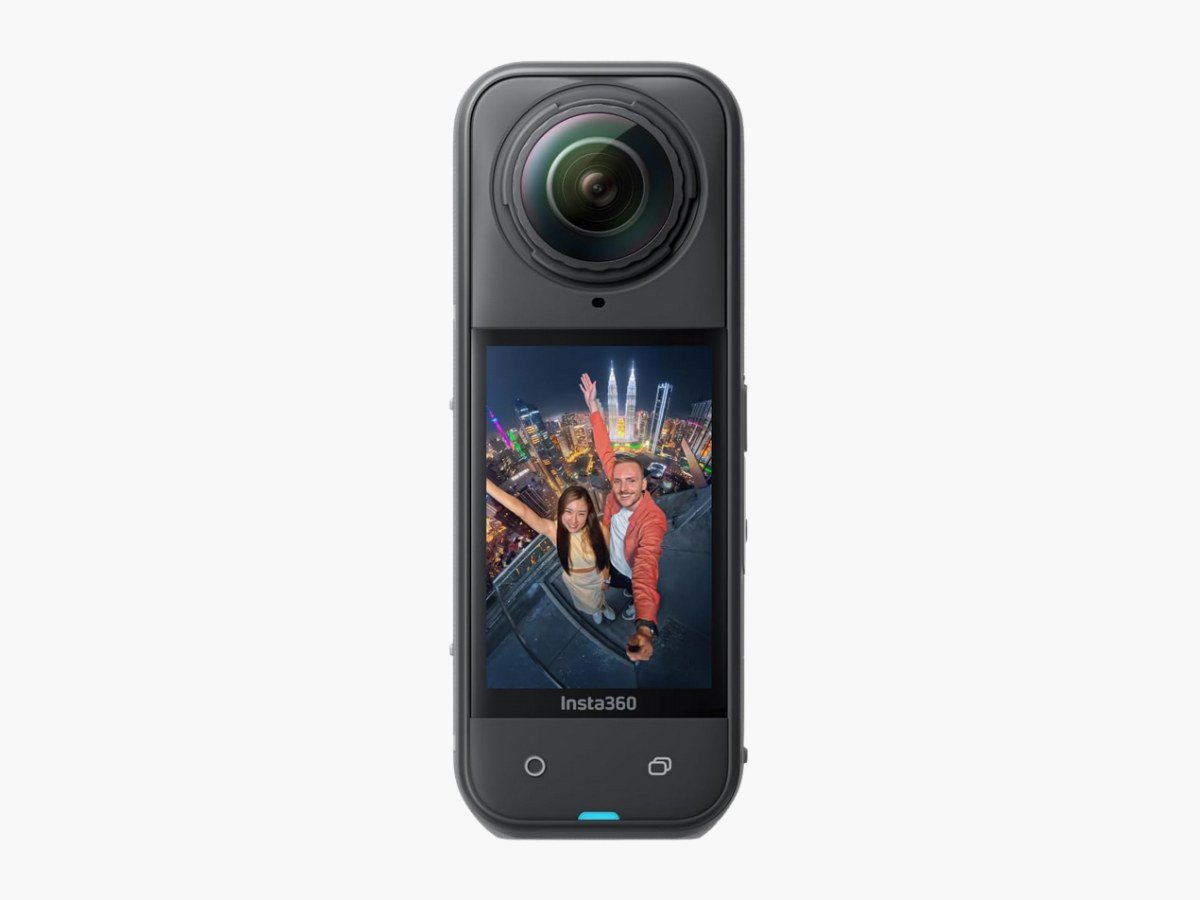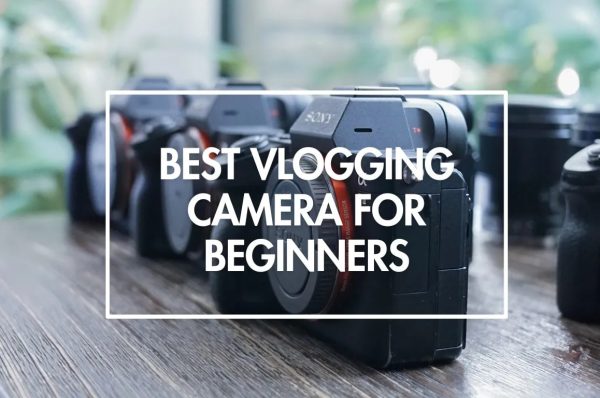You want to be able to make a vlog, but you can’t decide about the right vlogging equipment? We get it. A vlogging camera gives you all-inclusive features and ability to make professional video content right away. Their vlog friendly features and high-end video making ability can fulfill your dream to become a vlogger. The best vlogging cameras, as we see them, offer a range of features and prices for casual beginners and advanced content creators.
Best Vlogging Cameras
- Best Overall: Sony Alpha 6700 Camera
- Best Value: GoPro Hero 13 Black Camera
- Most Compact: Canon EOS R50 V Camera
- Best For YouTube: DJI Osmo Pocket 3 Camera
- Easiest To Use: Insta360 X5 Camera
You don’t need a lot of expensive gear to start vlogging. An idea for your YouTube channel or other video sharing platforms is enough to get started. For most people, the gear they have is a smartphone—and today’s smartphones are capable of some cinema-grade video. But there are a few key reasons you might eventually want to upgrade to a dedicated vlogging camera. It becomes the next logical step when your phone’s capabilities fall short.
While shooting videos on your smartphone is a good decision to start making vlogs, a dedicated camera can help take your videos to the next level. There’s no single best camera when it comes to vlogging, just as there’s no single way to make vlogs. Choosing the right option depends on your specific needs, whether you’re just starting out or looking to upgrade your current equipment.
Choosing the right vlogging camera comes down to understanding your specific needs rather than chasing the highest specifications. Different kinds of vloggers will make use of different features, and there’s no single camera that works perfectly for everyone.
We’ve Independently Tested 120+ Vlogging Cameras
We’ve tested over 120 cameras to help you find the best match for your vlogging style and budget. From compact point-and-shoots to full-frame mirrorless cameras, each option we recommend is a perfect match with your vlog making style and budget.
VERDICT
After further testing, the Sony a6700 is our new pick for an all-inclusive vlogging camera, replacing the a6400.
Best Vlogging Camera
When you’re ready to really step up your videos, the Sony α6700 vlogging camera offers the best combination of image quality, stabilization, and price. It showcases the best of hybrid camera technology. Its 26.0MP back-illuminated APS-C Exmor R CMOS sensor works with the advanced BIONZ XR processor to shoot extremely high quality videos and images
Its pixel-level 5-axis optical image stabilization makes handheld vlogging smooth and easy. Its in-body stabilization balances 5 different types of camera shake and keeps your videos smooth even in rough shooting conditions. The Active SteadyShot mode adds digital enhancement that produces gimbal-like results through in-camera processing.
You can shoot 4K resolution at up to 120 frames per second, which adds cinematic slow-motion effects to your vlogs. It records 10-bit 4:2:2 video at bitrates up to 600 Mb/s, giving you professional-grade color depth and editing flexibility. You can also record in-camera time-lapses and 4K at 120 fps for high-resolution slow-motion video. No need to worry about overheating, the a6700 can record 4K30p for over 2 hours or 4K60p for more than 40 minutes on a 128GB card without shutting down.
Its autofocus system is remarkably advanced, thanks to AI-powered autofocus system stands out with 759 phase-detection points covering 93% of the frame. Its dedicated AI Processing Unit recognizes and tracks humans, animals, birds, insects, cars, trains, and airplanes accurately. For vloggers, the eye-tracking functionality proves invaluable, maintaining precise focus on your eyes even when moving or changing positions.
Its high-capacity NP-FZ100 battery lets you take about 570 shots using the LCD screen or 550 shots with the EVF. For video recording, it lasts around 120 minutes continuously. You can power the camera through USB from a computer or power bank. The 4k at 120fps and in-body stabilization ranks Sony Alpha 6700 the best Sony camera for vlogging.
Best Vlogging Camera For Action and Sports
GoPro Hero13 Black is our best action camera due to HyperSmooth 6.0 Stabilization and video quality. GoPro’s latest HyperSmooth 6.0 technology has reshaped the scene of action cameras. This next-generation stabilization analyzes footage 4x faster than Hero12 model and proves incredibly smooth results whatever the terrain throws at it.
The intelligent AutoBoost feature improves stabilization automatically while keeping the smallest possible cropping margin. Thanks to its 360° horizon lock capability—your footage stays perfectly level even when the camera spins completely upside down.
Its 1/1.9″ sensor lets you make 5.3K video at 60fps, 4K at 120fps, and 2.7K at 240fps to create amazing slow-motion effects. The 8:7 aspect ratio sensor becomes invaluable for social media creators who can crop into vertical 9:16, widescreen 16:9, traditional 4:3, or full-frame 8:7 formats from the same footage. Its full 8:7 mode offers an expansive 156° field of view, so you capture all the action around you.
It is the only waterproof vlogging camera that works underwater up to 33 feet, making it perfect for surfing, snorkeling, or rainy conditions. You get three mounting options: classic fold-down fingers, a tripod thread, and a new magnetic mount for quick setup changes. The better 1900mAh Enduro battery runs up to 2.5 hours of continuous recording at 1080p30 or 1.5 hours at 4K30/5.3K30, so you never worry about power drain.
Its Media Mod transforms your Hero13 into a production icon due to its built-in directional microphone for enhanced voice capture, two cold-shoe mounts for accessories, plus 3.5mm mic input and HDMI-out ports. The removable foam windscreen effectively suppresses wind noise up to 20mph.
Its under performing in low light conditions but the premium features make it the best camera for action videos.
Best Vlogging Camera For 4K Resolution Videos
The DJI Osmo Pocket 3 brings professional 4K quality in a size that fits your pocket. It is an ultra-portable vlogging camera that combines three-axis gimbal mechanical stabilization and high dynamic range recording. in a pocket-size device. It’s perfect for vloggers who shoots in 4k resolution.
It records ultra high definition 4K footage, thanks to the 1-inch CMOS sensor, which is larger than the 1/1.7-inch sensor found in pocket 2. You can create dramatic sequences with smooth playback. Like the much pricier Sony α6700, the Pocket 3 can record at up to 4K resolution at 120 fps. This allows for clear, sharp picture quality and extra-smooth slow-motion footage. It also supports 1080p at 240fps for even more dramatic 8x slow-motion effects. Professional options include 10-bit D-Log M and 10-bit HLG for greater flexibility during post-production.
The Pocket 3’s lens sits on a built-in gimbal that let it to lock onto a subject and stay focused, even if it—or you—is moving around. You’ll get impressive control ranges (pan: -235° to 58°, tilt: -120° to 70°, roll: -45° to 45°) to capture shots from almost any angle. The system responds quickly with a maximum speed of 180°/s, making it perfect for dynamic vlogging that work for virtually any shooting angle. The gimbal’s angular vibration range of just ±0.005° ensures professional-level stabilization that outperforms the digital-only solutions you get in smartphones and many compact cameras. You can choose between three gimbal modes: Follow, Tilt Locked, and FPV, depending on your shooting style.
The built-in 1300mAh battery runs longer than you’d expect from such a small device. A full charge gives you 116 minutes of 4K/60fps recording or 166 minutes at 1080p/24fps. The charging speed impresses – you get 80% battery in 16 minutes and a full charge in about 32 minutes with PD chargers. The Creator Combo’s Battery Handle adds 62% more running time with its 950mAh battery.
Its Creator Combo comes with everything you need. You get all the essential accessories, like a tripod, a battery grip, and a wireless lavalier mic kit. The DJI Mic 2 integration allows direct connection to two transmitters simultaneously for dual-person audio recording—perfect for interviews or collaborative vlogs. The package also includes a wide-angle lens for an expanded 108° field of view and a carrying bag for convenient storage. The DJI Osmo Pocket 3 vlogging camera shows what’s possible in small pocket design. It professional 4K quality, great stabilization, and creator-friendly features proves it best for 4k vlogging.
Best Premium Vlogging Camera
The Sony ZV-E1 is our best high-end vlogging camera due to excellent low-light performance and stabilization. When you’re ready to step up to full-frame video quality, the Sony’s ZV-E1 brings cinema-quality vlogging capabilities through its full-frame excellence and compact design. It has the same 12.1MP Exmor R sensor found in Sony’s A7S III and FX3 cinema cameras, yet costs significantly less. Its 12-megapixel full-frame sensor might seem modest compared to high-resolution stills cameras, but this design choice enables extraordinary low-light performance with dual native ISOs at 640 and 12,800. You can record virtually noise-free footage up to ISO 25,600, with manageable results even at ISO 51,200.
AI features revolutionize solo vlogging on the ZV-E1. Auto Framing leverages AI processing to track subjects and automatically adjusts shots like a professional camera operator. The system crops a 4K-resolution image while showing the complete angle of view on the monitor. The Framing Stabilizer keeps subjects centered during movement by combining Dynamic Active stabilization with AI subject recognition. Advanced AI processing helps the camera track subjects by detecting eyes, body, and head positions—even as subjects turn away.
It records 4K at 60fps with no crop factor. A free firmware update adds 4K120p and 1080p/240fps options to create dramatic slow-motion sequences. Thanks to its 10-bit 4:2:2 color recording with S-Log3, S-Cinetone, and other picture profiles that offer 15 stops of dynamic range.
It has built in in-body stabilization system rated for up to 5.0 stops of smoothness. Dynamic Active SteadyShot mode boosts stabilization 30% more than standard Active mode. The results match the smoothness of latest GoPro action cameras.
It uses on Sony’s high-capacity Z battery with USB Power Delivery support for quick charging. You can take around 570 shots or record 120 minutes of continuous video recording per charge. Sony created the world’s smallest and lightest full-frame interchangeable lens camera with in-body stabilization.
Best Mid-Range Vlogging Camera
Sony’s Alpha ZV-E10 II is the best value for your money as it proves itself as a great vlogging camera that delivers amazing value. It takes everything good about the original ZV-E10 and upgrades all its limitations.
It records 4K footage at up to 60 frames per second with just a 1.1x crop at the highest frame rate. For standard 4K30 recording, the camera oversamples from a full 5.6K readout, which means you get exceptionally detailed video. Plus, it supports internal 10-bit 4:2:2 color recording with bitrates as high as 600Mbps—that’s professional-level color depth that gives you much more flexibility when editing.
You’ll love the automatic focus switching. The Product Showcase mode automatically shifts focus from your face to any object you hold up to the camera without any manual adjustments. Your videos stay professional without the annoying focus hunting.
Its autofocus system is impressively capable. With 759 phase-detection points covering 93% of the frame, the ZV-E10 II tracks subjects far more effectively than the previous E10 model, which only had 425 points covering 84% of the frame. The camera can reliably track humans, animals, or birds, making it versatile for different types of content.
It lacks in-body stabilization, but digital stabilization works well. While the ZV-E10 II doesn’t have the physical image stabilization found in higher-end cameras, its Active SteadyShot electronic stabilization does a solid job of smoothing out handheld footage, especially when you’re not moving around too much.
The audio options are thoughtfully designed because its built-in three-capsule microphone offers adjustable pickup patterns—you can set it to capture audio from in front of the camera for vlogging, behind the camera for narrating, or from all directions for ambient sound. Both 3.5mm microphone and headphone ports let you connect external audio gear if needed.
The interface is designed for regular vloggers. Its fully articulated touchscreen makes self-recording straightforward for you, and the updated menu system supports full touch functionality. For a more cinematic look, you can use the quick CineVlog option to apply Sony’s S-Cinetone color profile and shoots in a 2.35:1 aspect ratio at 24fps.
You can notice that the improvements over the original ZV-E10 are significant: a higher-resolution 26MP sensor versus 24MP, internal 10-bit recording instead of 8-bit, 4K60 capability compared to 4K30 maximum, better battery life with 610 shots versus 440, improved rolling shutter performance, and a more user-friendly menu system makes it the best vlogging camera for money.
Best Budget Vlogging Camera
The Sony ZV-1F is as an excellent startup camera for beginner level creators ready to move beyond smartphone vlogging. It hits the sweet spot between user-friendliness and performance for entry level vloggers.
Its touchscreen makes controls simple. The 3-inch fully articulating touchscreen offers excellent visibility with 921,600 dots and rotates up to 270 degrees for easy self-recording. It also gives you quick access to key settings while vlogging, including the useful Product Showcase AF mode. A clean button layout keeps things simple yet practical, with a dedicated video record button and custom function controls. You can start recording, adjust focus, and change basic settings without digging through complex menus.
It delivers quality that smartphones can’t match. The ZV-1F records 4K video at 30fps and Full HD at up to 120fps for smooth slow-motion effects. Its large 1-inch sensor and F2.0 lens enable professional-looking background blur that smartphone cameras struggle to achieve naturally, giving your videos a more polished appearance.
You can use content creator-focused features like Product Showcase mode, which automatically shifts focus when you hold objects up to the camera—perfect for unboxing videos or product reviews without manual focus adjustments.
Its audio quality is a step up from phones, thanks to built-in 3-capsule microphone with directional options ensures clear audio capture, while the included windscreen effectively reduces outdoor noise.
It has some limitations to consider like it relies entirely on electronic stabilization to smooth handheld footage, which works reasonably well but lacks the effectiveness of optical stabilization found in more expensive options. Walking footage may still appear somewhat shaky without a tripod or gimbal. The price makes it affordable vlog camera for beginners. Currently priced at $549.99, the ZV-1F represents excellent value within Sony’s creator-focused lineup.
Best Upper Mid-Range Vlogging Camera
Canon’s EOS R50 V takes a different approach to vlogging cameras with its video-first appraoch. Instead of adapting a traditional camera for content creation, Canon built this camera specifically for vloggers who occasionally need stills along videos.
The “V” designation signals Canon’s commitment to video creators. This marks Canon’s first interchangeable lens camera designed primarily for video rather than photography. Canon removed the electronic viewfinder completely, dedicating the entire back panel to a large vari-angle touchscreen that’s optimized for self-recording. This design choice makes perfect sense for vloggers who rarely use viewfinders anyway.
Dual record buttons make self-recording effortless. The camera features recording buttons both on top in the traditional location and on the front face for easy access when filming yourself. The rear panel packs five buttons and a multi-controller into a minimal space, while a video-focused mode dial offers eight different video modes with just one setting for still photography.
It records 4K with multiple format options including 4K at 59.94p with a 1.56x crop factor or 4K at 29.97p using the full sensor width oversampled from 6K. You can shoot Full-HD slow-motion at 119.8p across the full sensor width. Its professional features include 10-bit recording with advanced codecs like XF-HEVC S YCC422, XF-HEVC S YCC420, and XF-AVC variants.
It’s packed with vlogging-specific features like Close-up Demo mode automatically shifts focus to products held up to the camera—similar to Sony’s Product Showcase but with Canon’s implementation. Smooth Skin mode enhances your appearance on camera, complemented by 14 different color filters for creative looks.
Its audio capabilities match its video focus. Both microphone and headphone ports support professional audio monitoring. Canon even added a second tripod socket on the right side specifically for vertical video shooting—a thoughtful touch for social media creators.
Digital stabilization works well for moderate movement due to 5-axis Movie Digital IS with in-lens stabilization when available. Without in-body stabilization, you can use the digital correction that works best for static shots or subtle movements rather than walking footage.
Best Compact Vlogging Camera
The Sony ZV-1 II vlog camera proves itself as the perfect compact option for travel vloggers who want both portability and professional quality as it weighs just 10.3 oz (292g), making it easy to carry during long days of shooting. It shoots 4K video at 30 frames per second, giving you sharp footage of your travels. You can switch to Full HD resolution at 120fps to capture stunning slow-motion shots of waterfalls or street scenes with 5x slow-motion effects.
The camera’s XAVC S format delivers professional-quality footage with 8-bit color depth. It also stands out with its specialized video profiles like HLG, S-Log2, and S-Log3. These profiles give you more room to edit, though you’ll need to be careful with heavy color grading due to the 8-bit limitation. Its advanced autofocus works great for travel vlogs with 315 phase detection and 425 contrast detection points. Up-to-the-minute tracking keeps your face in focus even as you walk through busy markets or scenic spots. The camera locks onto faces and eyes smoothly, following the main subject throughout your shots.
The new Multi-face Recognition mode adjusts the aperture automatically when more people join the frame. This keeps everyone sharp in those spontaneous group shots during your travels. The Product Showcase mode quickly changes focus to objects you hold up—perfect to show off local finds or food.
The fully articulating touchscreen helps you nail your travel shots from any angle. You can frame shots easily whether you’re filming yourself at landmarks or getting scenic b-roll. The screen responds quickly and can turn the camera on or off when you flip it.
Moving shots get better with Active SteadyShot digital stabilization. This mode improves stability but crops the image about 1.25x. Your wide 18mm equivalent focal length becomes roughly 24mm, which still works well.
Unfortunately, Active SteadyShot can’t be used when recording slow-motion footage at 120fps,so your slow-motion shots won’t get that extra smoothness. For static shots, you’ll want to turn stabilization off to prevent electronic “float”. While its digital-only stabilization and 8-bit recording have limitations, the overall specs still offer tremendous value for video creators who demand portability.
Best Portable Vlogging Camera For Travel
If you’re looking for the best 360-degree camera for vlogging, the Insta360 X5 is our favorite choice. It takes a completely different approach to vlogging by capturing everything around you in 360 degrees, then letting you choose your perspective later. So traditional framing worries are gone completely.
The Insta360 X5 takes a completely different approach to vlogging by capturing everything around you in 360 degrees, then letting you choose your perspective later. It captures incredibly detailed 360° footage, thanks to dual 1/1.28″ sensors that are 144% larger than X4 model. It’s ability to record 8K30fps 360° video ranks it at the top of all other 360 cameras. When you crop into specific angles during editing, you’ll still get approximately 4K resolution. It actually captures near 11K worth of data before processing it down to 8K.
The reframing flexibility removes your concern about camera angles while recording, so you simply record everything and decide on your shots later. The invisible selfie stick effect creates unique third-person views that look almost like drone footage.
It’s surprisingly portable for a 360° camera. The X5 goes beyond standard recording with its PureVideo mode which uses triple AI processing chips to improve low-light performance by approximately two stops over the X4. You can use its all new InstaFrame mode to make a reframed flat video for quick sharing and a complete 360° version you can edit later.
It’s built to handle adventure shooting. The X5 features IP68 waterproofing to 49ft (15m). More importantly, it’s the first major 360° camera with fully replaceable lenses. If you damage a lens during risky shooting, you can swap it yourself using the $29.99 Replacement Lens Kit rather than sending the entire camera for repair.
Stabilization works remarkably well. Its FlowState stabilization with 360° Horizon Lock produces extremely smooth footage whatever your movement. Shakes and bumps disappear even when mountain biking or off-road driving. The Insta360 app provides AI-powered editing tools that can create automatic highlights.
Its battery performance and processing power see major improvements. Compared to the X4, the X5 offers extended battery life of 185 minutes versus 135 minutes, plus 140% more processing power with triple AI chips.
How To Select a Good Vlogging camera
We’ve put together a guide to help you choose the right vlogging camera for your needs, from compact point-and-shoots to full-frame options optimized for low light. Whether you’re considering full-frame for advanced video work or looking for something more portable, this guide will help you find the perfect camera for your specific content style and budget.
What is the Right Type of Vlogging Camera You Need
The best vlogging camera can transform your videos from amateur-looking footage into professional-quality videos that actually attract subscribers. Today’s vlogging cameras come purpose-built with flip-out touchscreens, directional microphones, and excellent autofocus—features specifically designed for people who film themselves.
You need to match your content needs with the right vlogging camera by understanding what each type does best. Each camera shines in different situations – from indoor studio work to outdoor adventures.
Mirrorless Cameras: The Versatile Choice For Vlogging
Most of the vloggers use mirrorless cameras because they give you great image quality without the weight of DSLRs. These cameras don’t need optical viewfinders or mirror mechanisms, so they’re more compact but still pack professional-level performance.
The Sony α6700 shows why mirrorless cameras are great for vlogging. It has an APS-C sensor that shoots 4K video at 60 frames per second and records in 10-bit log format. This makes color correction much easier later. The camera takes 6K footage and compresses it to 4K, creating videos that look way better than what you’d get from a smartphone.
The Sony ZV-E10 II gives you similar features at a lower price. In spite of that, you’ll miss out on built-in stabilization. You can work around this by using lenses with optical stabilization and turning on electronic stabilization.
Action Cameras: For Adventurous Video Content
Adventure and extreme sports vloggers need action cameras. These tough little devices can handle conditions that would destroy other cameras. The GoPro Hero13 Black really shines with its image quality and stabilization. You get an ultra-wide 177-degree view that captures almost everything in front of you – that’s much wider than the DJI Pocket 3’s 92-degree view.
One cool thing about the Hero13 Black is its 8:7 aspect ratio sensor. You can record both horizontal and vertical formats from the same shot. This helps creators who post on different platforms with different video orientations. Pro users will love that the Hero13 can shoot 10-bit log footage for better color grading. It also has time-code sync to help you line up footage from multiple cameras.
Point-and-Shoot Cameras: Built for Serious Vlogging
Modern compact cameras pack impressive capabilities into pocket-sized bodies, offering significant upgrades over smartphones without the complexity of interchangeable lens systems.
The Sony ZV-1 II is designed explicitly to serve as a point and shoot vlogging camera. Priced at $900, it features a 1-inch stacked sensor significantly larger than the image sensors found in most mainstream smartphones. That larger sensor is paired with an f/1.8–4 Zeiss lens, which lets a lot of light fall on the sensor despite its compact size.
The flip-out touchscreen lets you easily frame selfie shots. On the touchscreen, you can choose your focus point, start or stop recording, and access commonly used settings. The ZV-1 II doesn’t have an ultra-wide lens like most high-end phones, but at its widest zoom setting and held at arm’s length you should be able to fit your face and shoulders in the frame.
It lacks in-body image stabilization. Unlike mirrorless cameras, the ZV-1 II relies on software to stabilize shots. While it’s not as effective as sensor-shift or optical stabilization, we found that Active Steadyshot stabilization on 4K video produced relatively smooth footage.
DJI’s Osmo Pocket 3 is another great choice. It combines a 1-inch sensor with a built-in 3-axis gimbal that keeps everything steady. You can shoot up to 4K at 120fps, which lets you create both sharp normal videos and smooth slow-motion clips.
360-degree Cameras: For Immersive Perspectives
All the 360 cameras use two lenses pointing opposite ways to capture everything around you at once. Your viewers can look around your videos, or you can get creative with reframing during editing.
The Insta360 X5 leads the pack in consumer 360 cameras. It records 8K spherical video and works better in low light than older models. While it might not match GoPro’s regular video quality, being able to capture everything around you opens up tons of creative options. You can add smooth pans, fake drone shots, or focus on specific details when you edit – all from one recording. Travel vloggers love this flexibility when they want to show off amazing locations.
Full-frame cameras: For Ultra High Quality
Full-frame cameras give you the best possible video and image quality, which really matters in tough lighting. Their bigger sensors catch more light, giving you cleaner footage in the dark and better contrast.
The Sony ZV-E1 shows what full-frame can do for vloggers. It has helpful features like a front recording light, flip-out screen, and AI framing help. Solo creators can get pro-looking shots without needing someone behind the camera. You can shoot full-width 4K at 60fps, and it has several advanced stabilization modes. The auto-framing feature adjusts your shot as you move – just like having a camera operator.
How We Tested and Picked Vlogging Cameras
We spent days researching and testing vlogging gear. We reviewed each camera for the essential test factors to rate the earned score. Different kinds of vloggers will make use of different features, but there are key features that every video creator is going to need, so we made sure our tests had them checked.
Autofocus and Tracking
The right autofocus can make your footage look professional instead of blurry and unusable. Our tests showed how cameras work with phase-detection autofocus systems that quickly adapt to scene changes. Face and eye tracking is vital for solo vloggers because it helps keep the subject in sharp focus during movement. The best cameras let you touch the screen to focus, which gives you precise control without messing with buttons.
We tested autofocus by filming walk-and-talk sequences to check focus during movement. The cameras also had to prove how smoothly they could switch focus when new subjects entered the frame—something you’ll need when showing products or interviewing guests.
4k Video Resolution
Your vlog camera should record 4K video at the very least. The 4k resolution packs four times more pixels than 1080p, which gives you sharper details and more editing options. Recording in 4K lets you crop your footage without losing quality, which works great for reframing shots or creating dynamic transitions. Mid-range camera models offer 60fps or even 120fps at 4K resolution. We also checked for recording limits like crop factors at higher frame rates and potential overheating during long recordings.
Slow-motion Recording
Slow motion adds creative possibilities to your vlogs. Current cameras create slow motion by recording at higher frame rates than standard playback. You’ll get modest effects at 60fps, while 120fps at 1080p creates more dramatic results.
High-end cameras can hit 240fps in full HD, letting you slow down footage 10x when played at 24fps. We checked how cameras handle shutter speed in slow-motion mode—they should follow the double frame rate rule to avoid motion artifacts.
Sensor size and Image Quality
Your camera’s sensor size substantially affects video quality, especially in low light. Bigger sensors catch more light and produce cleaner footage in dim settings. Full-frame sensors work best in low light and create shallow depth of field, followed by APS-C, Micro Four Thirds, and 1-inch sensors in compact cameras.
We looked at dynamic range, color accuracy, and detail in different lighting conditions. Skin tones got extra attention since vloggers spend lots of time on camera.
Stabilization
Professional vlogs need stable footage. We compared cameras with in-body image stabilization (IBIS), lens-based optical stabilization (OIS), and electronic stabilization (EIS). The best systems use multiple methods—mechanical for big movements and electronic for small adjustments. Walking shots showed us how cameras handle shake, especially on rough ground. Some newer models record gyroscopic data for extra stabilization in editing.
Flip Screen Display
Solo vloggers need a flip screen more than any other feature. These screens rotate forward so you can check your framing, exposure, and focus while recording. Touch functionality on these screens lets you adjust settings without reaching around the camera body. Screen brightness matters outdoors, so we tested that along with touch response and accessory compatibility. Some cameras automatically switch to vlog mode when you flip the screen forward.
Built in WiFi and Live Streaming
Content creators work better with good connectivity features. WiFi lets you transfer footage to your devices without cables. This helps you stick to posting schedules while traveling or working away from your setup. WiFi also lets you control your camera through smartphone apps—perfect for solo creators who need to change settings while on camera. Better models can stream directly to YouTube or Instagram without extra hardware.
Battery Performance
Battery life is an uncompromising factor because vlogging cameras shoot for 2-3 hours straight while smartphones die within an hour of 4K recording. That’s why cameras with swappable batteries are a big deal as it means that you can keep filming longer on your travels. Wide-angle lenses help capture big landscapes. The Sony ZV-1 II comes with an 18-50mm equivalent lens that’s wide enough to film yourself while showing the scenery behind you.
Microphone Input and Audio Quality
Bad audio can destroy great video. We started by testing built-in microphones, checking their directional pickup and wind noise handling. External microphones through 3.5mm inputs showed how much audio quality improved. The best setups include headphone jacks to monitor audio levels while recording. Advanced users will appreciate manual audio controls to manage loud segments or boost quiet scenes.
Match the Camera to Your Vlogging Style and Content Needs
Your content creation needs should match your vlog camera’s features. You’ll need to know how tech specs work in real-life situations to pick the right camera for your shooting style.
Travel and Outdoor Vlogging
Travel vloggers put a lot of focus on how easy it is to carry and how tough their cameras are. Every ounce counts while hiking through tough spots or checking out new places. The Lumix G series gives you great performance in a light package. You’ll need good stabilization if you shoot outdoors. The Sony ZV-1 II uses Active Steadyshot stabilization that makes your footage look smooth even though it’s just software – perfect for walk-and-talk videos. A grip or tripod like the Joby GorillaPod 1K Kit can help steady your shots even more.
Studio and Indoor Video Content
Image quality and sound become more important than portability in controlled indoor spaces. Full-frame cameras like the Sony ZV-E1 work great in low light – which helps a lot in studio setups where lighting isn’t always perfect. The bigger sensor catches more light and gives you cleaner footage with better range. Heat management matters if you record longer videos. Some cameras stop recording because they get too hot – something to think about for long interviews or demos. The Sony ZV-E1 handles long recordings well without issues.
Action and Sports Vlogging
Action content needs tough gear. The GoPro Hero13 Black works underwater down to 33 feet (10 meters) without extra cases. Its HyperSmooth 6.0 keeps footage steady during wild activities like mountain biking or skiing, so you might not even need a gimbal. The Hero13 Black’s super-wide 177-degree view shows way more than regular cameras (the DJI Pocket 3 only shows 92 degrees). This wider view helps catch all the action in fast sports where getting the right shot can be tricky. Slow-motion adds drama to action shots. The Hero13 Black shoots up to 5.7K resolution, so you can slow things down and zoom in while keeping the quality sharp
Social Media and Vertical Video Content
TikTok and Instagram have changed how we shoot videos. The Canon PowerShot V1 lets you film vertical shots without turning the camera, working in both 16:9 and 9:16. This saves editing time since you won’t need to crop or change your footage later. Quick file sharing helps social media creators. Built-in WiFi lets you move files to your phone easily for quick edits and posts. Some cameras even let you stream straight to YouTube without extra gear.
Why You Can Trust Our Top Picked Vlogging Camera Reviews
Our expert guide stands out from typical reviews thanks to our in-depth testing approach. Our team spent over 50 hours testing and researching vlogging equipment. We tested cameras in a variety of environments. The testing process gave us a full picture of each camera’s performance in different lighting conditions.
Expert reviewers put each recommended vlog camera through several hours of real-life vlogging situations. Tests ranged from low-light recording, solo videos and fast pace action halls with multiple subjects. This helped ensure the cameras would work reliably in situations you’re likely to face. Your trust matters, so our vlogging camera picks come from objective assessments based on performance, not marketing hype.
Frequently Asked Questions
What features should I prioritize when choosing a vlogging camera?
Look for a camera with reliable autofocus, built-in stabilization, a flip screen for self-monitoring, good low-light performance, an external microphone input, and adequate battery life. The camera should also be compact and lightweight for easy portability.
Can I start vlogging with just my smartphone?
Absolutely yes. Modern smartphones have excellent cameras capable of producing high-quality vlogs. They offer convenience, built-in editing tools, and seamless sharing capabilities. Starting with your smartphone allows you to learn videography skills before investing in high end gear.
Is 4K resolution necessary for vlogging?
While 4K isn't essential, it offers benefits like sharper details and more flexibility in post-production. Even if you publish in 1080p, shooting in 4K allows you to crop footage without losing quality. However, for many vlogs, especially talking-head style videos, 1080p resolution is often working.
What camera is best for action and sports vlogging?
GoPro Hero 13 Black is our favorite for action and sports vlogging. They offer features such as waterproofing, advanced stabilization, ultra-wide field of view, and high frame rates for slow-motion footage.It's designed to withstand extreme conditions and capture smooth footage during high-motion and fast paced action.
How important is audio quality for vlogging?
Audio quality has major importance in any video. Even spectacular visuals can be undermined by poor sound. Look for cameras with good built-in microphones and the option to connect external microphones. For more advanced setups, consider cameras with manual audio level adjustments and headphone jacks for monitoring audio during recording.
